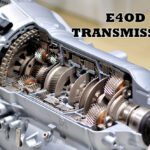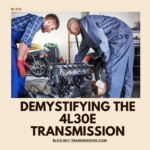Everything You Need to Know 4L30E Transmission
The 4L30E Transmission is a popular automatic transmission used in many cars today. However, not many people know much about this transmission or how it works. This lack of knowledge can make it hard to diagnose problems or make informed decisions when it comes to repairs.
Fortunately, in this post, we will demystify the 4L30E transmission and provide you with everything you need to know. We will cover the basics of how the transmission works, common problems and how to fix them, and maintenance tips to keep your transmission in top shape.
So, if you own a car with a 4L30E transmission or are just interested in learning more about transmissions in general, keep reading to find out everything you need to know.
Introduction to the 4L30E transmission
The 4L30E transmission is a popular automatic transmission used in various vehicles. Developed by General Motors and Aisin-Warner, this transmission has gained recognition for its reliability and smooth shifting performance.
The 4L30E transmission is commonly found in vehicles such as the BMW 3 Series, Isuzu Trooper, and Honda Passport. It is a four-speed transmission that operates electronically, meaning it utilizes sensors and electronic controls to optimize gear shifts for improved efficiency and performance.
Understanding the components
To truly understand the inner workings of the 4L30E transmission, it is crucial to familiarize yourself with its various components. This automatic transmission, developed by General Motors, is known for its durability and efficiency. Let’s take a closer look at the key components that make up this intricate system.
1. Torque Converter:
The torque converter serves as the link between the engine and the transmission. It allows the engine to continue running even when the vehicle is stationary, providing smooth engagement and torque multiplication.
2. Planetary Gear-sets:
At the heart of the 4L30E transmission are the planetary gear-sets. These gear-sets consist of multiple gears arranged in a way that allows for different gear ratios. By combining different gear arrangements, the transmission can provide various speeds and torque outputs.
3. Hydraulic System:
The hydraulic system is responsible for controlling the shifting of gears within the transmission. It utilizes hydraulic pressure to engage and disengage clutches, allowing for smooth gear changes. The hydraulic system also regulates the transmission fluid flow, ensuring proper lubrication and cooling of the transmission components.
4. Valve Body:
The valve body acts as the control center of the transmission, directing hydraulic fluid to the appropriate clutch packs and bands. It contains various valves and solenoids that respond to different driving conditions, such as throttle input and vehicle speed, to determine the optimal gear selection.
5. Clutch Packs and Bands:
Clutch packs and bands are essential for transferring power from the engine to the transmission output shaft. These components engage and disengage to control the torque flow and enable gear changes. They are carefully designed to withstand the high levels of heat and friction generated during operation.
6. Electronic Control Unit (ECU):
In modern iterations of the 4L30E transmission, an electronic control unit is employed to monitor and adjust transmission operation. The ECU receives input from various sensors, such as speed sensors and throttle position sensors, to make precise adjustments to shift points, line pressure, and other transmission parameters.
Understanding these components will allow you to grasp the inner workings of the 4L30E transmission and appreciate the complexity involved in its operation. By demystifying this essential automotive component, you can make informed decisions regarding maintenance, repairs, and upgrades, ensuring optimal performance and longevity for your vehicle.
Common issues and problems with the 4L30E
The 4L30E transmission is a popular automatic transmission used in various vehicles, but like any mechanical component, it can experience issues over time. Understanding the common problems associated with this transmission can help you identify and address them promptly, ensuring the longevity and performance of your vehicle.
One of the most prevalent issues with the 4L30E transmission is the failure of the torque converter clutch. This can result in symptoms such as slipping gears, poor acceleration, and even transmission overheating. If you notice any of these signs, it is crucial to have your vehicle inspected by a qualified technician to diagnose and repair the problem.
Another common problem is the failure of the shift solenoids. These solenoids are responsible for controlling the flow of transmission fluid and engaging the appropriate gears. When they malfunction, you may experience harsh shifting, delayed engagement, or even complete transmission failure. Regular fluid checks and maintenance can help prevent solenoid issues, but if you encounter any shifting abnormalities, it is advisable to have your transmission inspected.
Leaking transmission fluid is another issue that can plague the 4L30E transmission. A leak can occur from various points, such as worn seals, gaskets, or damaged transmission lines. It is essential to address any fluid leaks promptly, as low fluid levels can result in inadequate lubrication and eventual transmission failure. Regularly inspecting your transmission for any signs of leakage, such as puddles or stains on the ground, can help you detect and resolve these problems early on.
Lastly, electronic control module (ECM) failure is a common concern with the 4L30E transmission. The ECM is responsible for controlling various aspects of the transmission’s operation. If it malfunctions, you may experience erratic shifting, loss of power, or even complete transmission failure. Diagnosing ECM problems requires specialized equipment, so seeking professional assistance is crucial.
In conclusion, being aware of the common issues and problems associated with the 4L30E transmission can help you address them promptly and effectively. Regular maintenance, timely inspections, and seeking professional assistance when needed are key to ensuring the smooth operation and longevity of this transmission in your vehicle.
Diagnosing and troubleshooting
When it comes to the 4L30E transmission, diagnosing and troubleshooting can be a complex task. This transmission, commonly found in various vehicles, has its own set of unique issues that may arise over time. Understanding how to identify and address these problems is crucial for keeping your vehicle running smoothly.
One common issue with the 4L30E transmission is harsh shifting. If you notice abrupt and jarring shifts between gears, it could be a sign of a problem. This could be caused by low transmission fluid levels, a faulty solenoid, or even a worn-out clutch. It is important to check the fluid levels regularly and address any leaks or issues promptly.
Another problem that may occur is slipping gears. This can manifest as a delay in acceleration or a sudden loss of power while driving. Slipping gears can be caused by worn-out clutch plates, a malfunctioning torque converter, or a faulty transmission pump. If you experience this issue, it is recommended to have a professional mechanic inspect and repair the transmission.
Additionally, the 4L30E transmission may exhibit issues with overheating. Overheating can result from a variety of factors such as inadequate fluid levels, a malfunctioning cooling system, or a blocked transmission cooler. Regular maintenance and proper cooling system functioning are essential to prevent overheating and subsequent transmission damage.
When troubleshooting the 4L30E transmission, it is important to consult the vehicle’s service manual for specific diagnostic procedures and recommended solutions. However, if you are not familiar with transmission repairs, it is always advisable to seek the assistance of a qualified mechanic who specializes in transmissions.
By understanding the common issues and symptoms associated with the 4L30E transmission, you can take proactive steps to diagnose and troubleshoot any problems that may arise. Regular maintenance, prompt repairs, and professional assistance when needed will help ensure the longevity and performance of your vehicle’s transmission.
Proper maintenance and care for the transmission
Proper maintenance and care for the 4L30E transmission is crucial to ensure its longevity and optimal performance. As a complex and intricate component of your vehicle, it requires regular attention and care to prevent costly repairs and breakdowns.
First and foremost, it is essential to follow the manufacturer’s recommended maintenance schedule for the 4L30E transmission. This typically includes regular fluid changes, filter replacements, and inspections. The transmission fluid should be checked and replaced at the specified intervals to maintain its lubricating and cooling properties.
Additionally, it is important to keep an eye on the transmission fluid level and condition. Low fluid levels can lead to inadequate lubrication, which can cause excessive wear and damage to internal components. On the other hand, dirty or contaminated fluid can negatively impact the transmission’s performance. If you notice any unusual color, odor, or particles in the fluid, it may be a sign of a problem and should be addressed promptly.
In addition to regular maintenance, there are a few other steps you can take to care for your 4L30E transmission. Avoid excessive towing or carrying heavy loads beyond the recommended capacity, as this can put unnecessary strain on the transmission. When starting your vehicle, allow the engine and transmission to warm up before putting it into gear. This allows the fluid to circulate and reach optimal operating temperature, reducing wear on the transmission.
Furthermore, if you notice any signs of transmission trouble such as slipping gears, delayed engagement, or unusual noises, it is crucial to have it inspected by a professional technician. Early detection and prompt repairs can prevent further damage and potentially save you from costly repairs down the line.
By following these maintenance and care tips, you can ensure that your 4L30E transmission operates smoothly and reliably for years to come. Remember, a well-maintained transmission not only prolongs its lifespan but also enhances the overall performance and efficiency of your vehicle.
Upgrades and modifications for improved performance
When it comes to improving the performance of your 4L30E transmission, there are several upgrades and modifications that you can consider. These enhancements can help enhance its durability, responsiveness, and overall efficiency.
One popular upgrade is installing a shift kit. A shift kit modifies the valve body of the transmission, allowing for quicker and firmer shifts. This can improve the overall performance and drivability of your vehicle, especially during high-performance driving or towing situations.
Another option to consider is upgrading the torque converter. The torque converter plays a crucial role in transmitting power from the engine to the transmission. Upgrading to a high-performance torque converter can help improve the launch and acceleration of your vehicle, providing better overall performance.
Additionally, you may want to explore upgrading the clutch packs and bands within the transmission. These components are responsible for transferring power between gears. Upgrading to high-performance clutch packs and bands can help improve the overall strength and durability of the transmission, allowing it to handle higher torque and horsepower levels.
Lastly, consider upgrading the transmission cooler. An upgraded transmission cooler can help maintain optimal operating temperatures, preventing overheating and extending the life of your transmission. This is especially important if you regularly engage in heavy-duty or high-performance driving.
Before making any upgrades or modifications, it’s crucial to consult with a professional or reputable transmission specialist. They can provide expert advice based on your specific vehicle and driving needs, ensuring that the upgrades are compatible and appropriate for your transmission.
By investing in these upgrades and modifications, you can unlock the full potential of your 4L30E transmission, enjoying improved performance and reliability for years to come.
As with any complex mechanical component, it’s natural for questions to arise regarding the 4L30E transmission. To help demystify this essential automotive part, we’ve compiled a list of frequently asked questions to provide you with everything you need to know:
1. What vehicles use the 4L30E transmission?
The 4L30E transmission is commonly found in various vehicles, including but not limited to certain BMW, Isuzu, and Honda models. It is often utilized in compact and mid-size cars, as well as some SUVs.
2. What are the common symptoms of a failing 4L30E transmission?
Signs of a deteriorating 4L30E transmission may include delayed or erratic shifting, slipping gears, difficulty engaging reverse, or unusual noises such as whining or grinding. It’s crucial to address these symptoms promptly to prevent further damage.
3. How can I extend the lifespan of my 4L30E transmission?
Regular maintenance is key to prolonging the life of your transmission. This includes changing the transmission fluid and filter at recommended intervals, ensuring proper fluid levels, and avoiding excessive towing or hauling beyond the transmission’s capacity.
4. Can the 4L30E transmission be repaired or rebuilt?
Yes, the 4L30E transmission can be repaired and rebuilt by experienced automotive technicians. However, it is essential to seek professional assistance to diagnose the issue accurately and carry out the necessary repairs or rebuilds using high-quality components.
5. Are there any common design flaws or weaknesses with the 4L30E transmission?
While the 4L30E transmission is generally reliable, some common issues include solenoid failures, valve body problems, and torque converter issues. Regular maintenance and early detection of these issues can help mitigate potential problems.
By addressing these frequently asked questions, we hope to provide you with a better understanding of the 4L30E transmission. Remember, if you have any specific concerns or encounter issues with your transmission, it’s always best to consult with a qualified mechanic or transmission specialist for accurate diagnosis and appropriate solutions.






